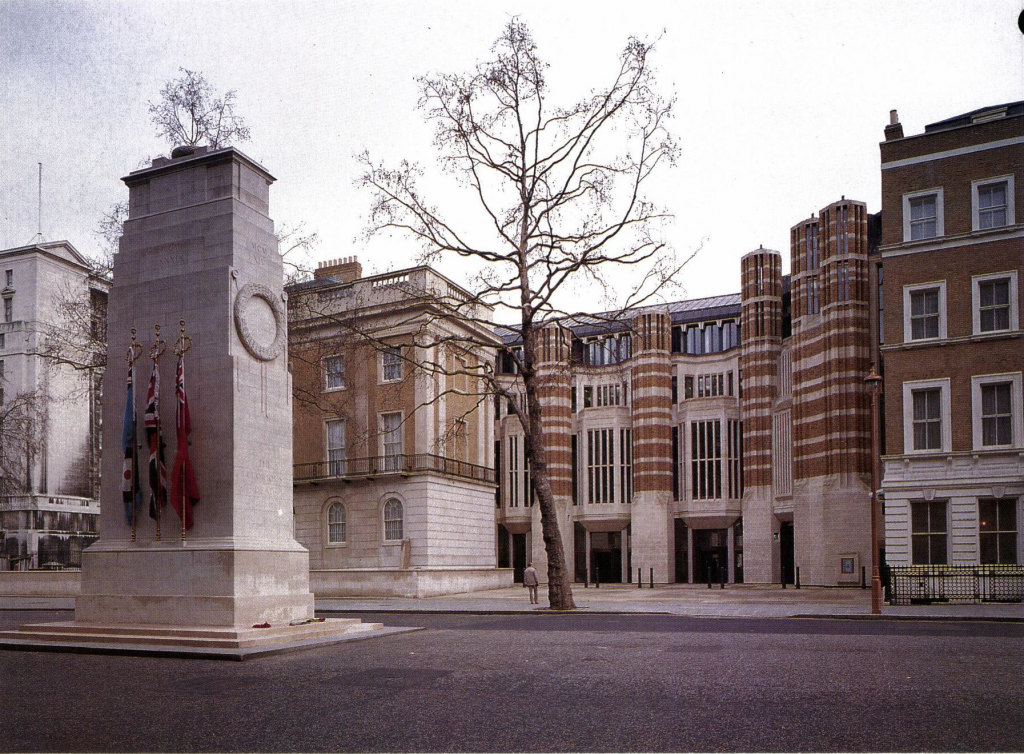Press release: Cathedral architects unite to condemn demolition of Richmond House as “needlessly destructive”

Image: Richmond House at Whitehall and interior (credit: Country Life)
19th August 2019
The chair of the Cathedral Architects Association Jane Kennedy and 13 of its members have signed a letter to The Times urging parliament to consider alternatives to the “needlessly destructive” plans to demolish Richmond House for a temporary MPs chamber.
Richmond House’s architect, Sir William Whitfield (1920 – 2019) was a leading cathedral architect, appointed Surveyor to St Paul’s and worked at Canterbury, Hereford and St Albans.
The letter published on 19th August states that, “The demolition of virtually the entire building to provide a site for a Commons chamber is needlessly destructive and we are urging parliament and the government to consider alternatives.”
It adds “Whitfield was a talented creative designer with an architectural language of his own, and highly sensitive and responsive to context. Richmond House is one of the best civic buildings of its era.”
Parliament’s Restoration and Renewal committee is currently drawing up plans to largely demolish Richmond House on Whitehall, built just 30 years ago, to make way for a new temporary chamber for MPs while the Palace of Westminster is being refurbished. It is part of a publicly funded £1.6bn rebuilding programme of the ‘Northern Estate.’
SAVE has highlighted at least four alternative locations for the chamber within the parliamentary estate which would be less destructive, less expensive and more environmentally friendly than the current plans. See the outline of alternative sites here, and our report on Richmond House as an exemplar low-energy government office building.
Image: Richmond House interior (courtesy of Country Life)
Andrew Arrol, architect to York Minister who signed the letter said in a statement of support to SAVE Britain’s Heritage: “I am completely opposed to the idea of the demolition of this building and there must surely be many other alternative locations for a temporary home for MP’s, and the Lords, when they have to vacate the Parliament building.”
Jonathan Louth, architect to St George’s Cathedral, Southwark Architect, and another signatory said: “Richmond House is not only as clever and fine as everyone states it to be, but is also one of the very few 12m wide, naturally lighted and potentially naturally ventilated buildings in Government use near parliament.
“As such, given there are viable alternatives that can be secured within the Whitehall cordon (most notably Hopkins offering to amend his own Portcullis House) Richmond House is absolutely the last one that should be thrown away unsustainably and replaced with a more energy intensive, carbon-embodied new footprint,” Louth added.
Jane Kennedy, chairwoman of the Cathedral Architects Association said: "I have long admired Richmond House and consider it to be a unique contribution to the art and architecture of public buildings in the twentieth century. The proposed alterations would destroy its fine interiors and would be a huge waste of good building. I am shocked and surprised that this is being proposed when there are plainly simpler and more exciting alternatives."
Marcus Binney executive president of SAVE said: “We are delighted to have such strong support from so many cathedral architects. They are responsible for the care of many of the finest and most important buildings in Britain. We call on all those in Government and Parliament promoting the virtual obliteration of grade II* listed Richmond House to withdraw their destructive proposals and look at the excellent, imaginative, sensitive and much cheaper alternative ways of providing a temporary House of Commons chamber.“
Parliament is expected to submit a planning application for the demolition and redevelopment of Richmond House in autumn 2019.
Ends
Note to editors
1. For more information and images contact SAVE Britain's Heritage office@savebritainsheritage.
2. SAVE Britain’s Heritage has been campaigning for historic buildings since its formation in 1975 by a group of architectural historians, writers, journalists and planners. It is a strong, independent voice in conservation, free to respond rapidly to emergencies and to speak out loud for the historic built environment.
